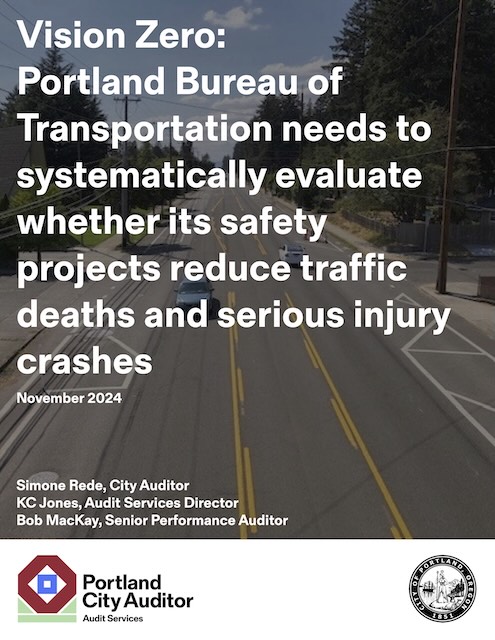Portland adopted a Vision Zero plan in 2016. At first, it seemed to be working; at least, traffic fatalities declined from 42 in 2016 to 35 in 2018. The only problem is that few of the steps of the plan had been implemented by 2018, so that decline was merely a coincidence.
 Click image to download a 2.1-MB PDF of this report.
Click image to download a 2.1-MB PDF of this report.
The plan called for reduction of speed limits, stricter enforcement of speed laws, reconfiguration of dangerous intersections, and improved street lighting. Not everything was completed, but some of it was and the city saw a dramatic change in fatality rates — upwards. By 2022, the city had 62 fatalities; so far in 2024 it has had 69, so by the end of the year it is likely to be more than double 2018.
Now the Portland City Auditor has released a report effectively blaming Vision Zero for the increase in fatalities. Aside from not doing everything the city promised to do in its Vision Zero plan, the report says that the basic problem is that city officials made no effort to find out if the actions it did take were working. Without such an evaluation, and a willingness to make course corrections to focus on things that work rather than ones that don’t, it is likely that traffic deaths would have doubled even if everything in the plan had been completed.
The audit concludes with a response from the city transportation bureau that completely sidesteps the issue. “The crash data clearly indicates that societal issues related to housing, behavioral health, substance abuse, and a culture focused on the individual are factors contributing to deadly and serious traffic crashes,” the agency said. “A societal commitment to meet basic human needs and implement strategies to change current conditions are necessary to reach many of our shared goals, including Vision Zero.”
In other words, it’s not the city’s fault if people don’t respond to the plan the way planners wanted them to; it’s the fault of the people who didn’t do what they were supposed to do. That’s just another way of saying that the city officials didn’t bother to evaluate whether their plan was working because, apparently, they didn’t care.
Note that the city is blaming the problem partly on “societal issues related to housing, behavioral health, [and] substance abuse.” As previously noted here, Portland says that 70 percent of 2021 pedestrian fatalities were homeless people. Federal data shows that most of those fatalities happened at night when pedestrians were crossing busy streets away from designated crosswalks, and often when they were inebriated.
The question is, since city officials have known about homeless fatalities since 2022, why haven’t they modified their Vision Zero plan to address the issue? The actions that are in the plan obviously weren’t treating this problem.
Antiplanner readers will remember that I found the same problems in Denver in 2023: the city had adopted a vision zero plan, fatalities increased, and the city did nothing to modify its plan to treat the real causes of that increase. My report made three suggestions — a motorcycle helmet law (which Colorado doesn’t have), bicycle boulevards, and moving homeless camps away from major arterials — any one of which would save more lives than vision zero was doing. Yet city officials made no effort to take these steps even while proclaiming alarm about traffic fatalities.
This seems to be the basic pattern of vision zero plans across the country: impose a bunch of auto-hostile policies, ignore the fact that they don’t work, and then blame others when fatalities rise. As Lewis & Clark law professor Jack Bogdanski says, “the bureaucrats are great at spending money to make life miserable for people who drive cars, but they don’t bother to see if any of their spending actually makes any difference in improving traffic safety.”








From my point of view, road design still plays a key role in this issue. It’s not always a good idea to prevent cars from high speed, but it is also a bad idea to keep bike riders away from wide boulevards. Actually, cars, buses and bikes can run smoothly at the same time like this video shows: https://youtu.be/6yMwniU4KUI?si=up9S0fVzyybz1C8D
washi, AP doesn’t care about anything done in other countries, are you new here?
I have contacted AP before, and he did not object to me providing examples from foreign cities. He also used examples from Japanese cities to illustrate how bike lanes should be designed. If it can give someone some inspiration, I don’t think there is anything wrong with sending some foreign examples.
derp, derp derp derp, derp derp
“He also used examples from Japanese cities to illustrate how bike lanes ”
Do you have a link?